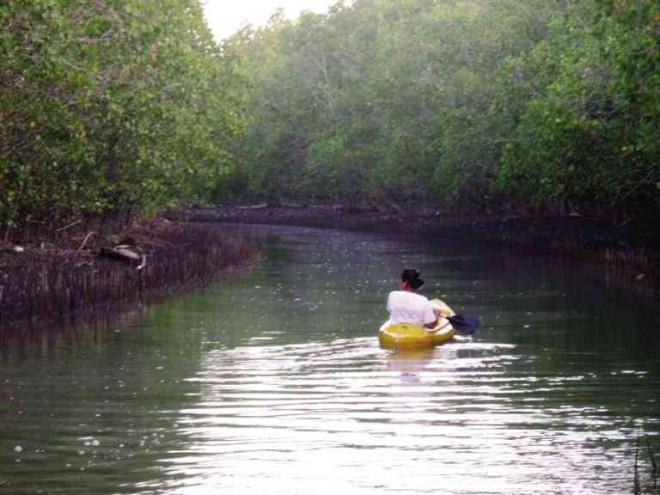Mindoro’s paradise island of mangroves

THE SILONAY Mangrove Conservation and Eco Park in the City of Calapan in Oriental Mindoro MADONNA T. VIROLA
Early in the morning, Alma Bool would plod through muddy waters and plant mangrove propagules off an island in the City of Calapan. She did not realize that she had already planted more than 3,000 of them until somebody asked.
The 42-hectare Silonay Mangrove Conservation and Eco Park on Silonay Island in Mindoro Oriental province has now become her “little paradise.”
For her daily sojourn to the sea, Bool, 37, was recognized, along with five other women, by the World Coral Reef Conference for her work on marine conservation in this part of the Verde Island corridor, also known globally for its high number of endemic underwater species.
The conference was held on May 13 in Manado, Indonesia, and initiated by Coral Triangle Initiative, which comprises six member-states—Philippines, Indonesia, Malaysia, Papua New Guinea, Solomon Islands and Timor Leste.
“The island-village of Silonay is one of the areas highly vulnerable to storm surges,” said Jocel Pangilinan, project manager of Ecosystem-based Adaptation to Climate Change of Conservation International Philippines (CI).
She cited the findings of CI’s 2009 Vulnerability Assessment of the Verde Island Passage, which occupies over 1.14 million hectares and is shared by Oriental Mindoro, Batangas, Occidental Mindoro, Marinduque and Romblon.
Silonay, situated in the eastern portion of Calapan, has been losing its mangrove forest due to rampant cutting of trees by residents to sell for firewood. The island has a population of 1,464 and a land area of 87 hectares.
With its natural protective barrier diminished, more than 100 houses were wiped out during a past typhoon, said Bobby Vergara, barangay (village) chair and president of the Sama-samang Nagkakaisang Pamayanan ng Silonay (SNPS).
Reforestation efforts led by SNPS have reversed the situation in Silonay.
New species Mangrove Forest Biodiversity
Surveys made by CI showed that the island’s mangroves species have increased in number from eight in 2009 to 14 in 2014. The conservation agency attributed the development to the “planting intervention” at the eco park.
Five years ago, it documented eight species—“pipisik puti” (Avicennia marina), “pipisik pula” (Avicennia officinalis), “pagatpat” (Sonneratia alba), “bakawan lalaki” (Rhizophora apiculata), “bakawan babae” (Rhizophora mucronata), “diliwaryo” or “daluari” (Acanthus ilicifolius), “buta-buta” or “lipata” (Excoecaria agallocha) and “nipa” or “sasa” (Nypa fruticans).
CI found six additional ones in its survey this year—“lapis-lapis” (Ceriops decandra), “tangal” (Ceriops tagal), “saging-saging” (Aegiceras corniculatum) and “pototan” (Bruguiera gymnorrhiza, Bruguiera sexangula and Bruguiera cylindrica).
Silonay is also a habitat for birds and bats. In 2013, CI listed 29 bird species, the most common of which were the yellow-vented bulbul (Pycnonotus goaivier), black-naped oriole (Oriolus chinensis) and the white-throated kingfisher (Halcyon chloris), and two bat species—the nectar bat (Macroglossus minimus) and fruit bat (Ptenochirus jagori).
There are also new species of geckos of the (Gekko gecko and Occidozyga laevis) species, which can be heard from the entrance of the mangrove boardwalk footbridge of the park.
Crash course
The A major attraction of the eco park is the mangrove boardwalk, which was launched on Nov. 13, 2013, in time for Oriental Mindoro’s founding anniversary. Near the entrance is a mural of Silonay species done by environmental artist AG Saño and local students.
Residents would welcome visitors and help point out areas of interest. When they stop at a store, they can hear bird calls amid a vast expanse of greenery and mangroves.
A 350-meter bamboo boardwalk leads to three cottages resting huts that can accommodate 10 people. Native baskets are for trash and tarpaulins bear reminders on how to care for the environment as part of a crash course on the ecosystem.
Atop a 6-meter high tower, which can carry 10 people, one can have a panoramic view of the island and the Silonay River, which exits to the sea.
A P50 entrance fee is charged (P20 for students). Visitors are, however, encouraged to plant mangrove seedlings in certain wetlands.
Some students, teachers, civic-minded people, government employees, beauty queens and foreign journalists have posted their encounters with nature at their Facebook account known as Silonay Mangrove Conservation Area and Ecotourism.
Locals also have their own stories to share, including that of Bool, SNPS treasurer and who once worked abroad as a domestic helper.
Rotone Faderanga, 30, used to cut mangrove trees and gather crabs to feed his two children, now aged 7 and 9. He is now one of the eco park guides and earns P2 per seedling planted.
One Saturday alone, Faderanga earned P2,000 when a group planted 1,000 seedlings, according to Bool. “He preferred to use his bare hands, without boots, to row seedlings” Bool said.
Other guides get P250-P300 a day, she said.
The provincial tourism office and Kapamilya Foundation have been training 15 to 20 guides, aged 17 to 35. Bool said the volunteers help protect the mangroves from loggers and maintain cleanliness.
Some villagers draw extra cash from selling souvenir items, snacks and handpainted T-shirts.
Indeed, Silonay is proud of its people’s green resolve.
This ecosystem-based climate change adaptation project was initiated by Conservation International – Philippines with support from the German Federal Ministry for the Environment, Nature Conservation, Building and Nuclear Safety through its International Climate Initiative. It is being implemented in partnership with the Provincial Government of Oriental Mindoro, City Government of Calapan and the Barangay Government of Silonay. The mangrove watchtower was funded through the Direct Assistance Program of the Australian Embassy.
Read more: https://newsinfo.inquirer.net/635142/mindoros-paradise-island-of-mangroves#ixzz3Ctdem5sT
Follow us: @inquirerdotnet on Twitter | inquirerdotnet on Facebook














